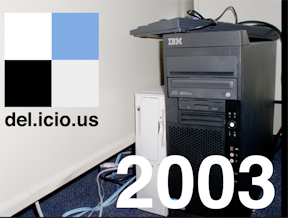My charter with Venture Files is to contribute to and promote entrepreneurship and the startup scene around DC in general. Now, as I’ve warned, my posts may reveal my bias towards the Web 2.0 world. (It’s what my startup is about.) But heck — I’m at the Web 2.0 Expo in NYC, so . . .
A session today of great interest was Joshua Schachter’s ‘Lessons Learned in Scaing and Building Social Systems.’ For many of us, Schachter lived the great American Web 2.0 dream:
Step 1. Build an app (del.icio.us) in your spare time, and operate it from your apartment (server ‘farm’ below);
Step 2. Sell it to Yahoo! (rumored to be in the neighborhood of $20M . . . nice neighborhood);
Step 3. Retire (he now devotes his time to playing XBox).

I can certainly relate to that!
Schachter’s talk on scaling wasn’t technical — he was referring to scaling the features, the very functionality of his social bookmarking site del.icio.us (now delicious.com).
Interestingly, Schachter built the application to solve a problem he had — he had a Word file with thousands of lines of links for all the web pages he bookmarked. Thus, the application’s initial value was utility. And that’s what Schachter would provide the world — a useful site for keeping track of favorite sites . . . and making your friends aware of them.
And for a couple of years, that’s what it did. But when the number of users got substantial, features surrounding the network effect eclipsed the site’s original value. Achieving a critical mass of users (file this under ‘high-class problem’) suddenly transformed the site’s functionality from a utility to a social application, giving Schachter a whole new set of issues to deal with — customer service, spam, kiddie porn. (“You see it all, when you get to scale.”)
Ultimately (for all of us), the focus of scaling shifts to revenue. Being ad-driven, for del.icio.us, that meant getting to more and more users and pageviews. Subtleties start to really matter, such as encouraging sharing among del.icio.us users (he saw, for example, that a disproportionate number were checking the ‘keep private’ box; it dropped dramatically when the label was changed to ‘do not share’ — as in, ‘what, you don’t want to share your toys, Johnny?’). Bingo.
“The problem, however, is that these features impact one another. Optimizing revenue often comes at the expense of user satisfaction — think of ad-splattered sites, or Evites that force you to visit the site, rather than providing details of the invitation in the email.”
Here are a few other nuggets:
Make your product self-marketing Provide as much functionality as you possibly can before asking people to register.
Want harmony on your site? Avoid conversations Schachter really disliked the flame wars that comments generate, so unlike digg, delicious.com to this day has none.
Listen to your users We’ve heard it a hundred times, but the best founders (Flickr, 37 Signals, WineLibraryTV) all really do it — Schachter read and answered every customer email up until a year ago, when the volume got so great, five people at a Yahoo! customer-support center had to be dedicated to it.
Learn your ‘drivers of infection’ The two most dramatic traffic-builders for del.icio.us were the Firefox plug-in and the RSS feed.
Great lessons for all of us.
